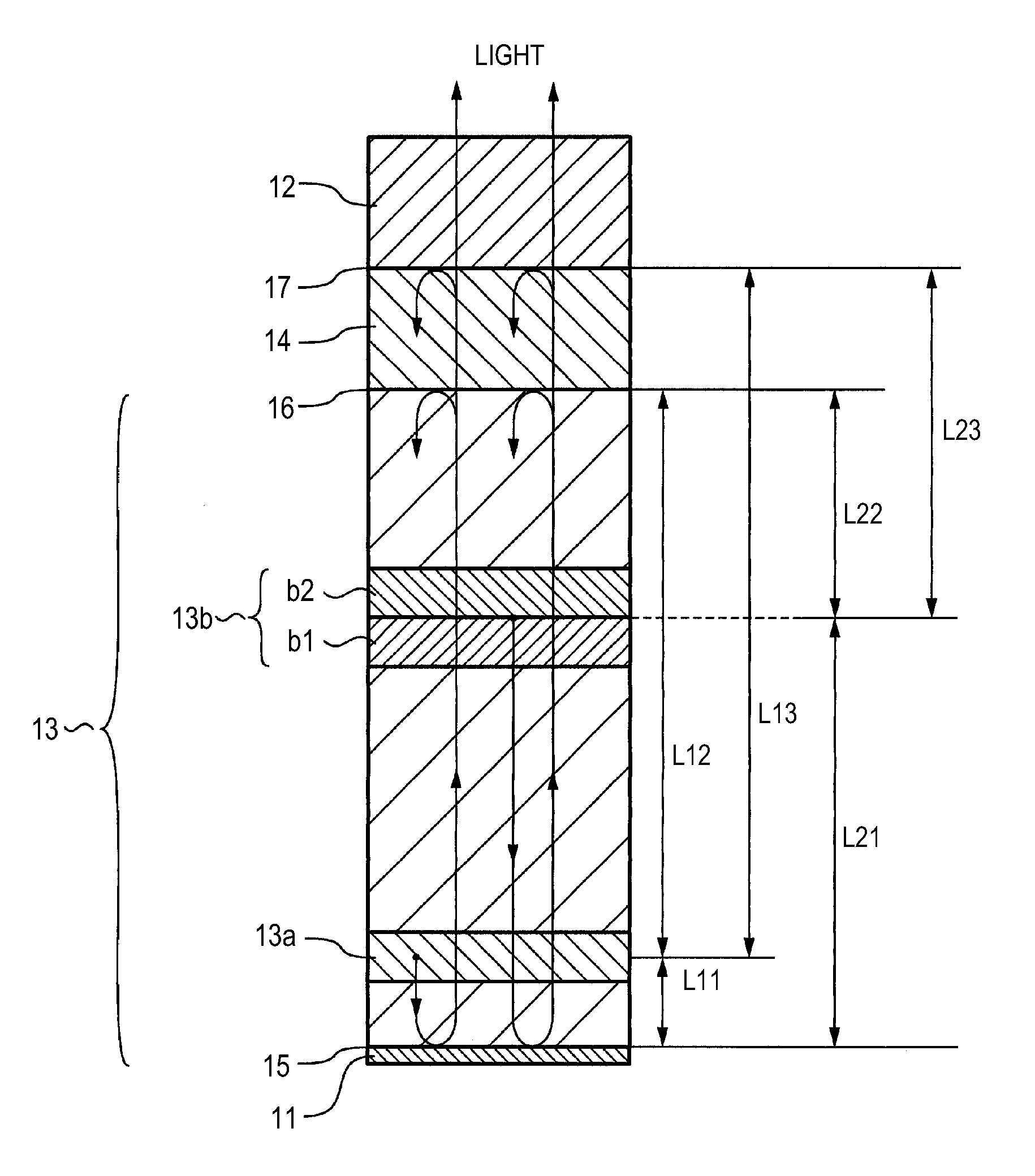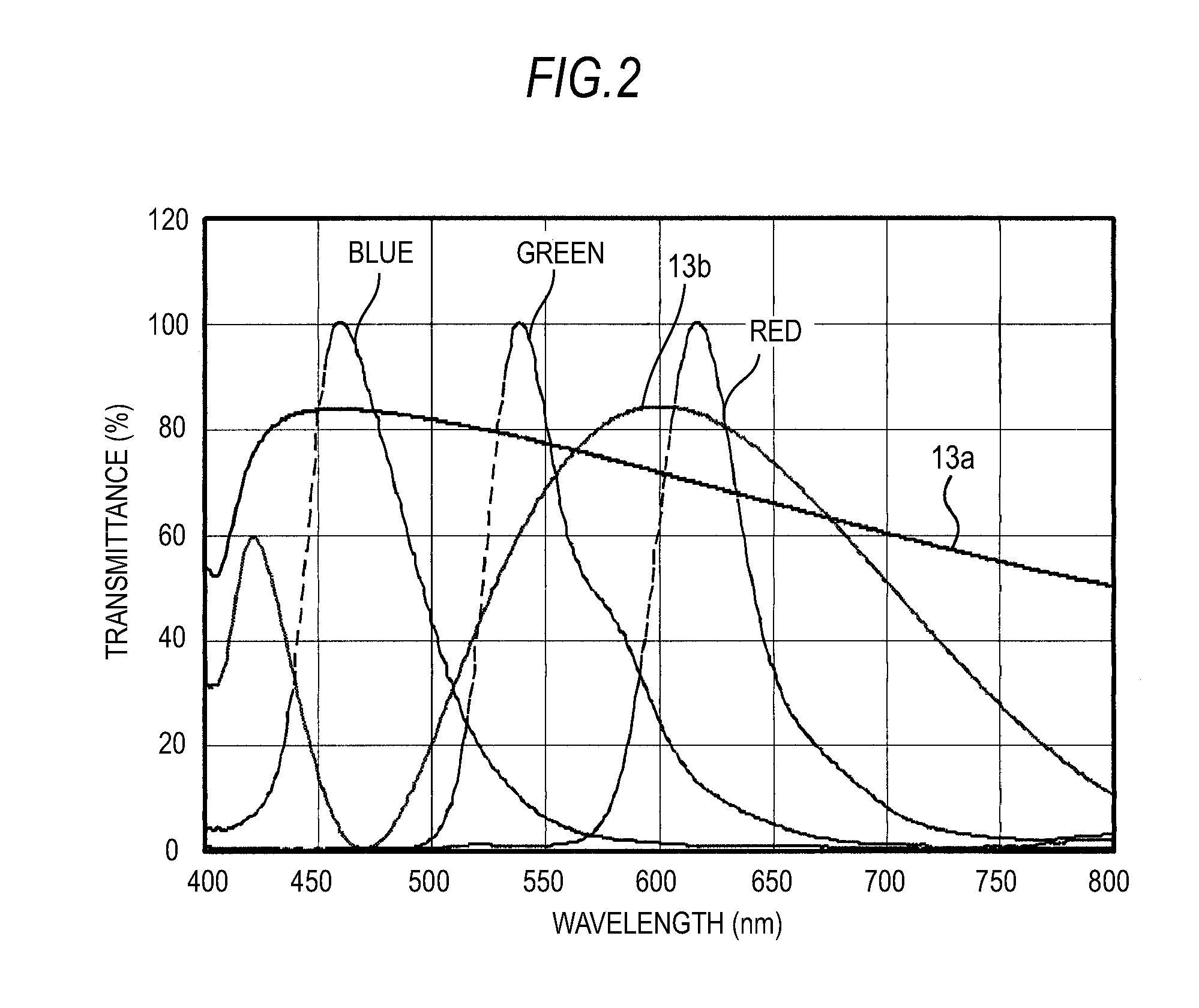Light-emitting device, illumination apparatus, and display apparatus
a technology of illumination apparatus and light-emitting device, which is applied in the direction of electric discharge tube, electric discharge lamp, incandescent envelope/vessel, etc., can solve the problems of increasing the dependence of viewing angle of emission characteristics, difficult to obtain white emission having a wide spectrum, and difficult to achieve phase cancellation, etc., to reduce the dependence of luminance and hue, reduce the dependence of viewing angle, and achieve the effect of extracting light in a wide wavelength rang
- Summary
- Abstract
- Description
- Claims
- Application Information
AI Technical Summary
Benefits of technology
Problems solved by technology
Method used
Image
Examples
first embodiment
1. First Embodiment
[0080]FIG. 1 shows an organic EL device according to a first embodiment.
[0081]As shown in FIG. 1, in this organic EL device, an organic layer 13 is interposed between a first electrode 11 and a second electrode 12, in which a first light-emitting layer 13a and a second light-emitting layer 13b are sequentially included in the organic layer 13 at mutually separated positions in that order in the direction from the first electrode 11 to the second electrode 12. Like the existing organic EL device, a hole injection layer, a hole transport layer, an electron transport layer, an electron injection layer, and the like, as necessary, are formed in portions of the organic layer 13 above or under the first light-emitting layer 13a and above or under the second light-emitting layer 13b. In this case, the second electrode 12 is a transparent electrode that transmits visible light, and light is emitted from the side of the second electrode 12. The first light-emitting layer 1...
second embodiment
2. Second Embodiment
[0098]In an organic EL device according to a second embodiment, the second and third reflective interfaces 16 and 17 of the organic EL device according to the first embodiment are respectively divided into two front and rear reflective interfaces so as to broaden the wavelength range of the opposite-phase interference conditions shown in the expressions (3) to (6). That is, as for the expression (3), for example, when the second reflective interface 16 is divided into two front and rear reflective interfaces separated by a distance of Δ, L12 becomes L12+Δ and L12−Δ, the wavelength range of λ12 in which the expression (3) is satisfied is broadened. The same applies to the expressions (4) to (6).
[0099]According to the second embodiment, in addition to the same advantages as the first embodiment, since the wavelength range of the opposite-phase interference condition shown in the expressions (3) to (6) can be broadened, it is possible to obtain an advantage that the...
third embodiment
3. Third Embodiment
[0100]In the organic EL device according to the first embodiment, there is a case where the portions of the light-emitting layers b1 and b2 of the second light-emitting layer 13b are formed by a stacked structure made up of a plurality of layers depending on a manufacturing method of the organic EL device or in order to obtain necessary properties. Thus, the portions become thick. Moreover, as for the stacking order of the green light-emitting layer b1 and the red light-emitting layer b2, it is preferable to stack the layers in the descending order of the emission wavelength from the side of the first electrode 11. That is, the green light-emitting layer b1 and the red light-emitting layer b2 are preferably stacked in that order from the side of the first electrode 11 similarly to the first embodiment. However, the stacking order of the green light-emitting layer b1 and the red light-emitting layer b2 may be reversed. In such a case, since it is difficult to regar...
PUM
 Login to View More
Login to View More Abstract
Description
Claims
Application Information
 Login to View More
Login to View More - R&D
- Intellectual Property
- Life Sciences
- Materials
- Tech Scout
- Unparalleled Data Quality
- Higher Quality Content
- 60% Fewer Hallucinations
Browse by: Latest US Patents, China's latest patents, Technical Efficacy Thesaurus, Application Domain, Technology Topic, Popular Technical Reports.
© 2025 PatSnap. All rights reserved.Legal|Privacy policy|Modern Slavery Act Transparency Statement|Sitemap|About US| Contact US: help@patsnap.com



